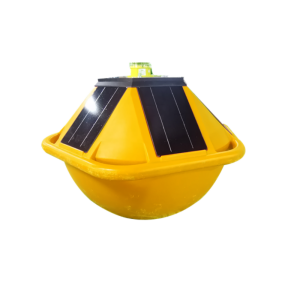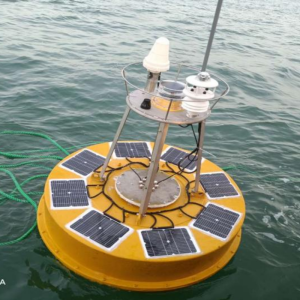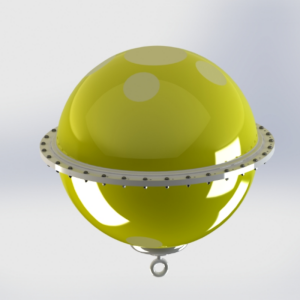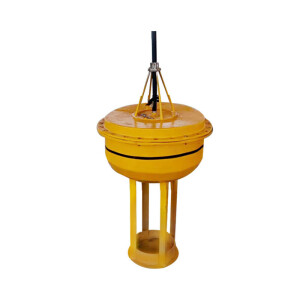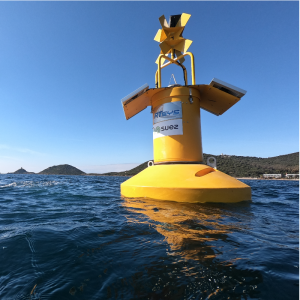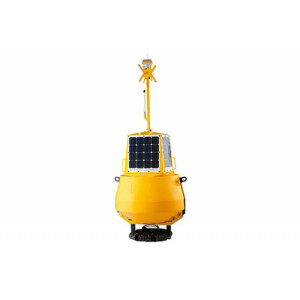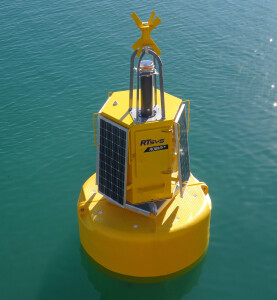

WIREWALKER™
Vertical Profiling - Powered by Ocean Waves
The Wirewalker is a rapid vertically-profiling instrument platform propelled by ocean waves which accepts a large range of sensor payloads.
Description
Del Mar Oceanographic produces the Wirewalker, a vertically profiling instrument-platform powered by ocean waves. Through the Wirewalkers rapid profiling and ability to integrate a wide variety of sensor payloads, it brings new life to typical one-dimensional sensor time-series as a 2-D depth-time image where an enormous increase in information and intuition is achieved. Attached to a free-drifting or moored buoy, the Wirewalker ratchets downward along a suspension wire under wave power. At a predetermined depth (up to ~1000 m), the ratchet releases. The profiler then ascends at its terminal velocity (~0.5 m/s), completely decoupled from sea-surface motion. A very clean data record is obtained to within 1 meter of the sea surface. Typical round trip profiling speeds are 10 meters/minute. Contact us to learn more; we'd love to assist you in radically increasing your information content and enhancing your observations.
Specifications
-
General
-
Type
Drifting buoy, Moored buoy
Year of last update
2020
Year of introduction
2001
Length [m]
152.5
Width [m]
66
Hull material
Buoy hull is foam
Structure Material
Profiler is plastic
Ballast
20kg suspended weights
-
Power Supply
-
Battery
Profiling is powered by waves. No Batteries.
Battery type
External power for sensor operation is available. Alkaline/Lithium.
Solar panels
No
Solar panels description
No Solar panels on the standard buoy.
-
Software
-
Type of mission planning software
Integrated sensor dependent
-
Wave and tide variables sensors
-
Wave frequency
No
Wave height
No
Wave period
No
Wave direction
N
Current speed
Yes
Current direction
Yes
-
Operation Characteristics
-
Deployment methods
Free-Drifting or moored in place
Min deployment depth [m]
5
Max deployment depth [m]
1000
Anti-fouling systems
Sensor dependent
Max operating time
Sensor dependent
-
Positioning and navigation
-
GPS sensor
Y
GPS description
Iridium Beacon and clamps included
Navigation lights
Yes
Navigation lights description
Solar powered flasher included
Radar reflector
optional
-
Water variables sensors
-
Water depth
No
Water temperature
Yes, optional
Water salinity
Yes, optional
Water turbidity
optional
Chromophoric dissolved organic matter (CDOM)
optional
Nitrate
optional
Dissolved oxygen
optional
Chlorophyll
optional
Underwater radiance
optional
Sound Velocity
optional
Max. depth rating of sensors
1000m
Other sensors or additional information
The Wirewalker platform itself is 100% mechanical (no electronics/sensors). However, it's possible to integrate an applications specific suite of sensors as a payload.
-
Atmospheric and solar variables
-
Air temperature
No
Air humidity
No
Barometric pressure
No
Wind speed
No
Wind direction
No
Solar radiation
No
Other sensors or additional information
No atmospheric variables are standard on the buoy.
-
Application and Use
-
Training facilities
Main applications
Oceanography, CTD/density/soundspeed profiling, turbulence and ocean mixing, air-sea interactions, biogeochem, tactical oceanography, aquaculture, plume monitoring
Distinguishable features:
The Wirewalker uses only wave power to propel itself vertically though the water column. All on board power goes to the sensors. The ascent smooth and decoupled from the mooring wire.
-
Communication and data
-
Data logger description
The Wirewalker can accommodate a large range of underwater sensors and various payloads.
Web based control and tracking
No
Acoustic communication
No
Iridium/Satellite communication
optional
Cellular comunication
optional
UHF/VHF communication
No
Other sensors or additional information
It's possible for a sensor suite to communicate with a topside telemetry system via an inductive modem
